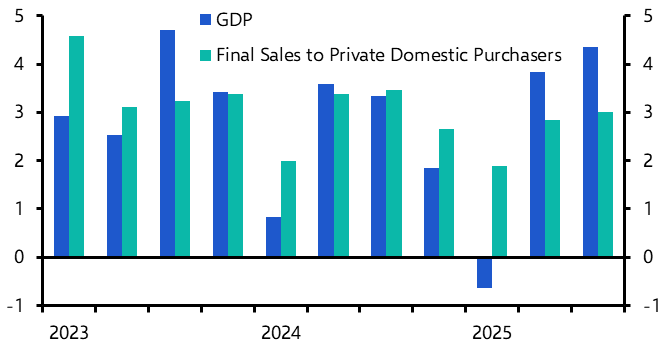Last week we held a series of conferences in North America. You can find recordings of our presentations here. Two recurring questions were asked by clients. The first was how the latest escalation in trade tensions between the US and China was likely to play out. The second was whether, by stepping back from further policy tightening, the Fed has set the scene for a period of sustained stronger growth in the US.
The blunt answer to the first question is that we simply don’t know – and anyone suggesting that they do is being disingenuous. After all, the trade war is not being driven by economic forces but rather by political calculations that are constantly shifting. That being said, from a macro perspective there are three points worth stressing.
First, while tariff escalation hasn’t helped, the slump in world trade over the past 6-9 months owes more to broader weakness in the global economy. Second, there are no winners from a trade war but it would require a significant escalation in protection, extending beyond just the US and China, to cause major economic damage on a global scale. Finally, despite this, trade wars are clearly a big concern for global equity markets. Our bearish view on global equities is rooted in a belief that the outlook for earnings is weaker than most investors anticipate, rather than worries about trade. But a re-escalation in the trade war would obviously add to the headwinds facing world stock markets.
What about the Fed? Our US service is the place to look for detailed analysis, but the starting point should be to distinguish between developments on the demand and the supply side of the economy. All other things being equal, looser monetary policy should support domestic demand in the US. But that only leads to additional output if there is a response on the supply side – either through firms hiring more workers, or through an increase in the productivity of existing employees.
The drop in the US unemployment rate to a multi-decade low probably overstates the tightness of America’s labour market. But even so, it remains the case that at this stage of the cycle there’s limited scope for a prolonged expansion in employment. Accordingly, anyone anticipating a pick-up in US GDP growth as a result of a more dovish Fed is implicitly banking on an upturn in productivity.
This is certainly possible. One of the big puzzles in macroeconomics over the past decade has been why the rapid development of new technologies, particularly in digital and AI, has not fed through to faster productivity and thus GDP growth.
The pessimists argues that this is because the latest wave of technological development is different from those in the past and that it will never produce a pick-up in productivity. In contrast, we’ve taken a more optimistic line. The recent weakness in productivity growth may in part reflect a hangover from the global financial crisis, which should eventually fade. More fundamentally, infrastructure and processes have to adapt to new technologies in order to fully realise the benefits to productivity and history shows that this takes time.
Whether or not this happens in time to extend the current economic cycle is unclear. But the acceleration in US productivity growth over the past year may be a sign that the tide is beginning to turn.
Our base case remains that US GDP growth will soften over the next year as the lagged effects of earlier monetary tightening and the fading effects of fiscal stimulus start to weigh on activity. But we should keep an open mind to the possibility that a productivity renaissance prolongs the economic cycle for longer than we anticipate. Either way, the key point is that if this does materialise it will be productivity - rather than the Fed - that saves the day.
In case you missed it:
(Requires login)
- Our China team analyses Beijing’s response to the imposition of new US tariffs, including its approach to the renminbi.
- Our Senior Europe Economist, Jack Allen, warns that Italy may be heading for another budget clash with the EU.
- With India’s election result looming, read all of our analysis here – including a comprehensive assessment of the potential economic and market implications.



